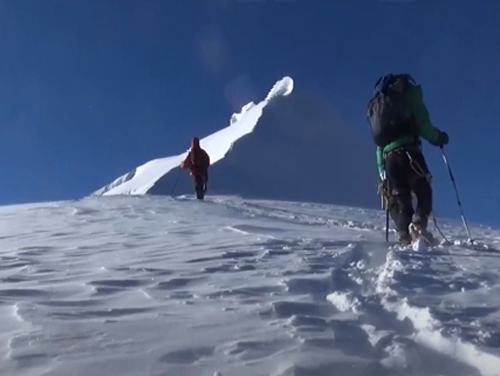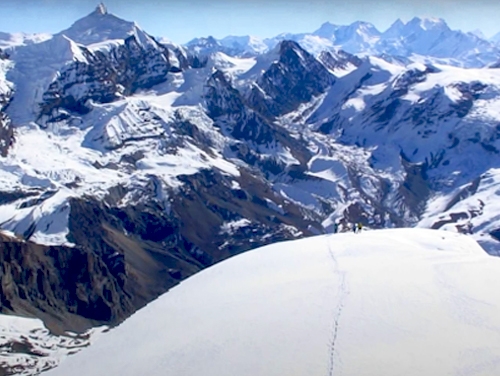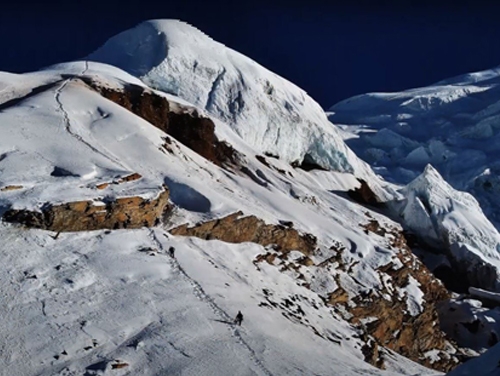Summary of Dhampus Peak Climbing
Dhampus Peak climbing is located northeast of the massive Dhaulagiri mountain. It is a simple peak to climb in terms of technical. Dhampus Peak is a fairly exposed site to watch the scenery due to the massive altitude variations between the Annapurna and Dhaulagiri ranges. With Tukuche Peak (6920m) and Dhaulagiri (8167m) so close, you get a sense of being at the extreme altitudes of the Himalayas.
Dhampus Peak climbing provides an excellent perspective of the nearby high mountains, such as Dhaulagiri (8163 m), Sita Chuchura (6611 m), Nilgiri (6940 m), Tukche Peak (6920 m), Tilicho peak (7134 m), Thorong Peak (6484 m), Yaskawa Kan (6482 m), Puth Hiunchuli (7246 m), Mukut Himal (6639 m), Tangu Peak (6197 m), Hongde peak (6556 m), Tsarste (6347 m) and many more.
In addition, the Dhampus peak climbing package can be added during the Dhaulagiri Circuit Trek which is a mesmerizing trek via the French pass, and Thapa Pass.
How to reach Dhampus Peak?
Dhampus Peak can be reached in two different ways. The first is from the Dhampus Pass. The second is from the mountain's Kali Gandaki valley side. The trail between Dhampus Pass and Yak Kharka camp is the starting point for this trek. Our groups take the Dhampus Pass route up and down. This is a long day with a rise of 1,000 meters from Hidden Valley.
Dhampus Peak Climbing Itinerary begins with a tourist bus ride from Kathmandu to Pokhara, followed by a private car ride from Pokhara to Naya Pul and hikes to Poon Hill, Ghasa, Tukuche, Marpha, and Alubari. And keep working your way up to the Dhampus top.
To climb the Dhampus summit, we camp further up to the summit after Marpha village. But we conduct a tea house trek from Pokhara to Marpha village. Our skilled team will set up camp in the Alu Bari (Yak Kharka) and Dhampus peak base camp with a whole team. Trek back to Jomsom and fly back to Pokhara after summiting Dhampus Peak. Then we will drive back to Kathmandu by bus.
How difficult is Dhampus Peak climbing?
In comparison to other peaks, the Dhampus peak climb is less difficult and lower in altitude. This mountain is also not as physically demanding as Island, Ama Dablam, or Mera Peaks. However, the difficulty of the Dhampus Peak climbing path is determined by the weather.
Some years, especially in early or mid-October, there is little or no snow on the path. The ascent is rather simple under current conditions. The trail is rocky, and there are some struggling steps higher up. If snow and ice are on the path, the ascent becomes much more difficult and demands mixed climbing at high altitudes.
Despite being a moderate climbing peak, the key to a successful summit is regular practice, proper acclimatization, endurance, and the resolve to climb higher. Climbing up via a challenging topographical terrain is required. As a result, adequate climbing preparation is required.
Dhampus Peak climbing Accommodation
Unless you choose to sleep in a tent, the best places to stay at Dhampus Peak Climbing are good inns run by locals. Each hotel has a main public space with a fireplace. While the bedrooms are unheated with beds and mattresses, as well as a blanket and pillows included. The meals given during the Dhampus Peak Climb are excellent, including a variety of local Nepali / Sherpa and western dishes.
We sleep with a four-season sleeping bag and a high-quality sleeping mat. Lower down, you may need to use a sleeping bag liner to avoid overheating while sleeping in an open zipped four-season bag. The porters will transport your essential stuff up to a weight of 15 kgs and can meet the needs of the entire group. You'll even have your guide and climbing sherpa with you the entire time to ensure your safety and satisfaction.
Dhampus Peak Climbing permit
The Nepal Mountaineering Association (NMA) is the government organization authorized to provide climbing licenses. Because of economic, safety, environmental, and cultural concerns, the government has imposed numerous limits and prohibitions on peak climbing activities.
Permit fees are collected by the government as part of its export earnings. Permits are necessary for mountain summits higher than 5000 meters in elevation. It is illegal to attempt to climb a peak without permission.
Permits are checked at all times by police and park rangers. The fines will be triple if you are caught without a valid permit. It also gives a return option if you don't have any permissions.
Booking Is Open for 2024 \2025
Emergency Evacuation during Dhampus Peak Climbing
In Nepal, helicopter rescue efforts are the most common means of dealing with an emergency, and there is a well-established system for organizing logistics. It is vital to get travel insurance in the area and to be honest with the insurance company about your holiday destination and what you intend to accomplish.
Your insurance provider may be able to arrange for a helicopter evacuation. However, you should file a claim and explain the issue to the insurance company. The greatest approach in the event of altitude sickness is to avoid risk and descend. Further elevation can rapidly lead to even more bad consequences.
Best Season for Dhampus Peak Climbing
Have you ever attempted a 6000-meter-high mountain climb? If you have, you must be aware of how lovely climbing is. Even if you haven't, you should make a plan to climb Dhampus Peak, one of the most spectacular climbing summits, at least once in your life.
The difficulty of climbing Dhampus Peak is also heavily influenced by one's level of preparation, planning, and weather. As a result, it is usually preferable to arrange your trip during the greatest seasons of the year. Because of the favourable weather, spring, and autumn are the greatest seasons for climbing. The weather is pleasant; it is not too freezing or too hot, and there is less rain. The busiest months are March to May and October to November. Because they are ideal for hiking in terms of weather, and trails become busy during this time.
Spring is primarily stable and dry, with a mild climate. Every day, the Annapurna region gives a crystal clear picture of the mountains and scenery during the Spring season. During the day, temperatures might reach 15 to 20 degrees Celsius. At night, the temperature might dip to - 8 to 10 degrees Celsius. The presence of thousands of flowers and vegetation in the spring makes the climbing more beautiful and delightful. If you have already done Dhumpus peak climbing, then some of the best selling peak climbing here Is Island peak climbing, Mera peak climbing.
Autumn is another fantastic time to hike Dhampus Peak. Temperatures in the autumn range from 12 to 20 degrees Celsius during the day and -5 to 9 degrees Celsius at night. During the ascent, there is a low possibility of rain and snowfall.



